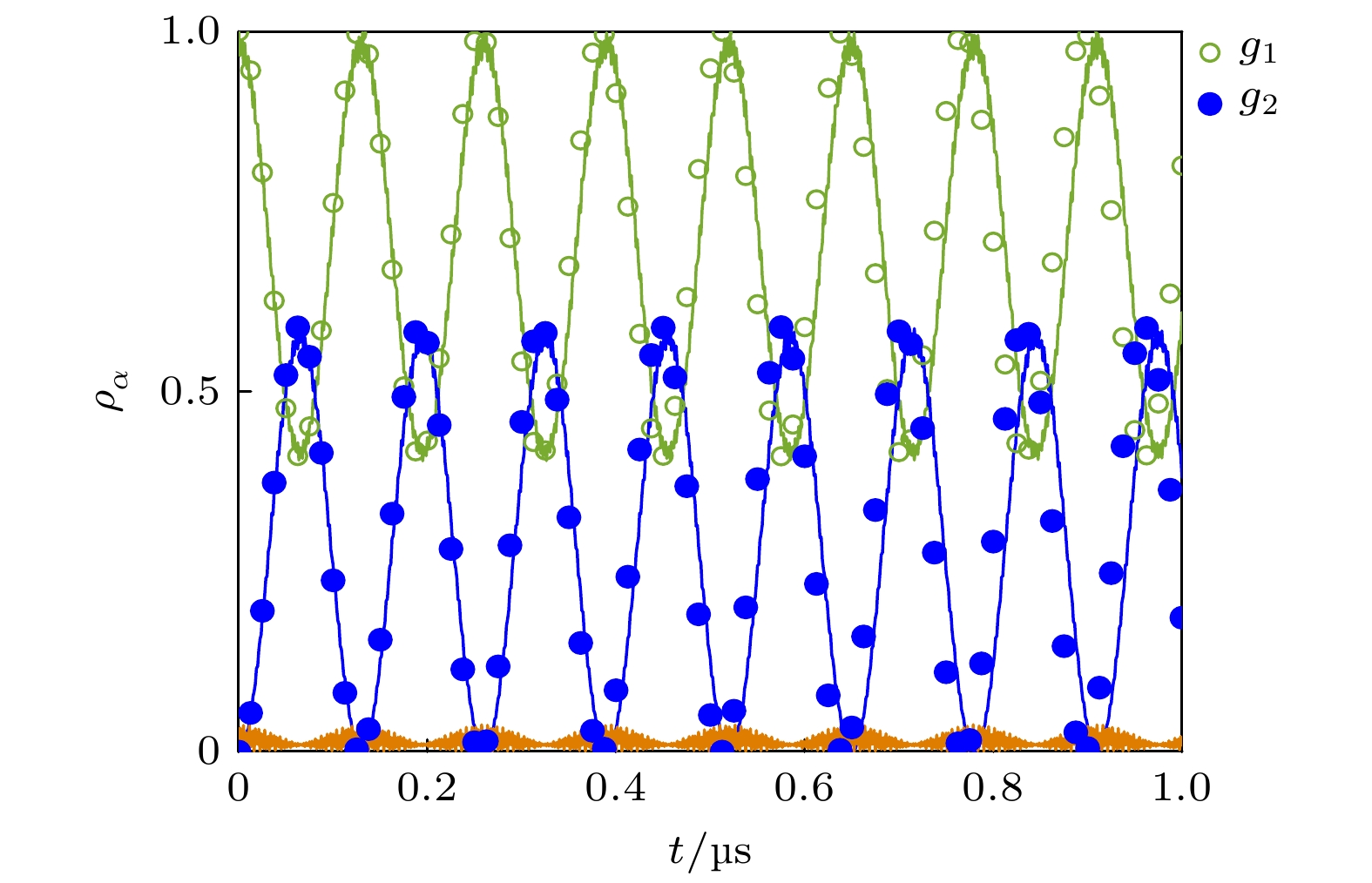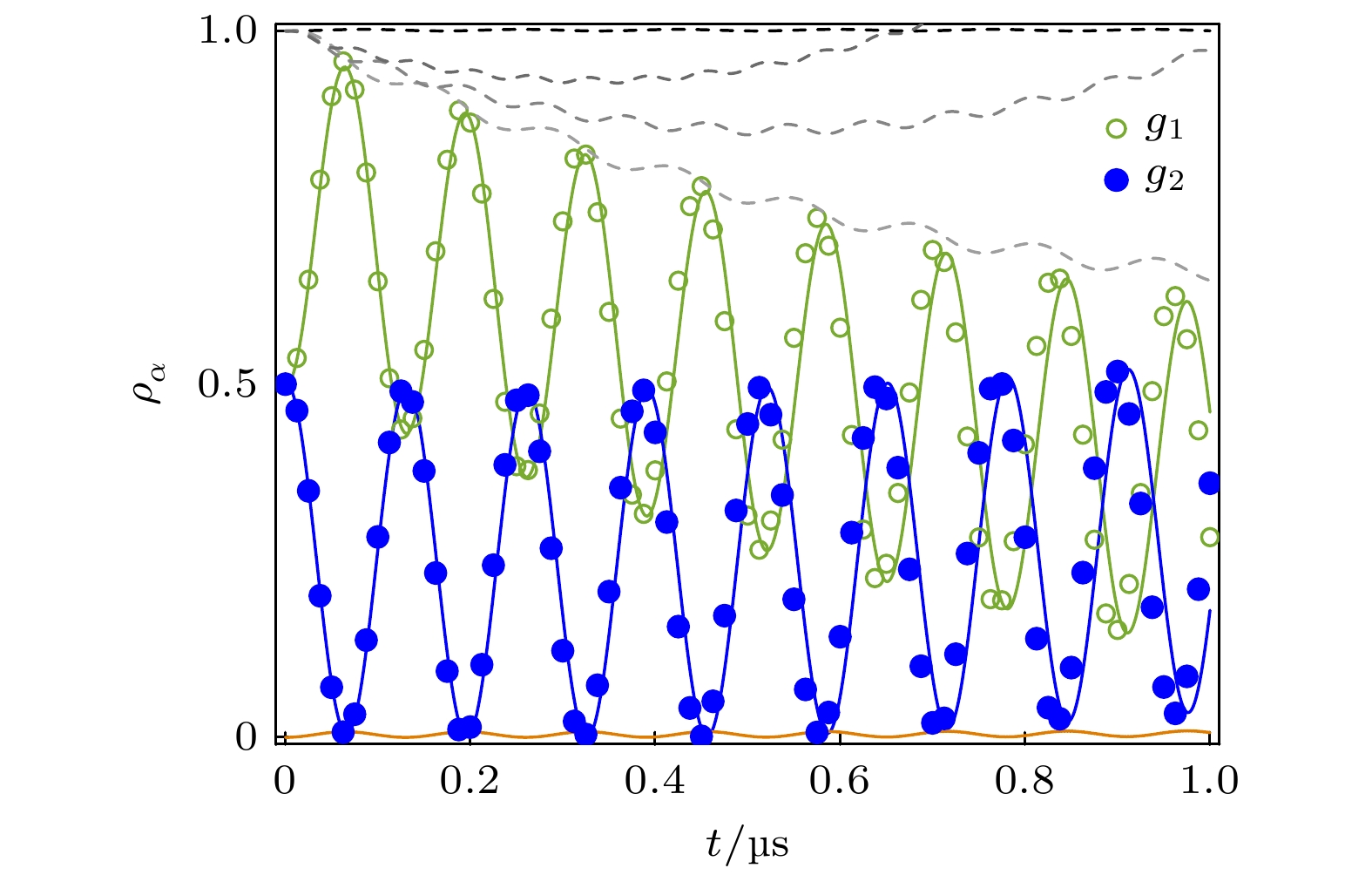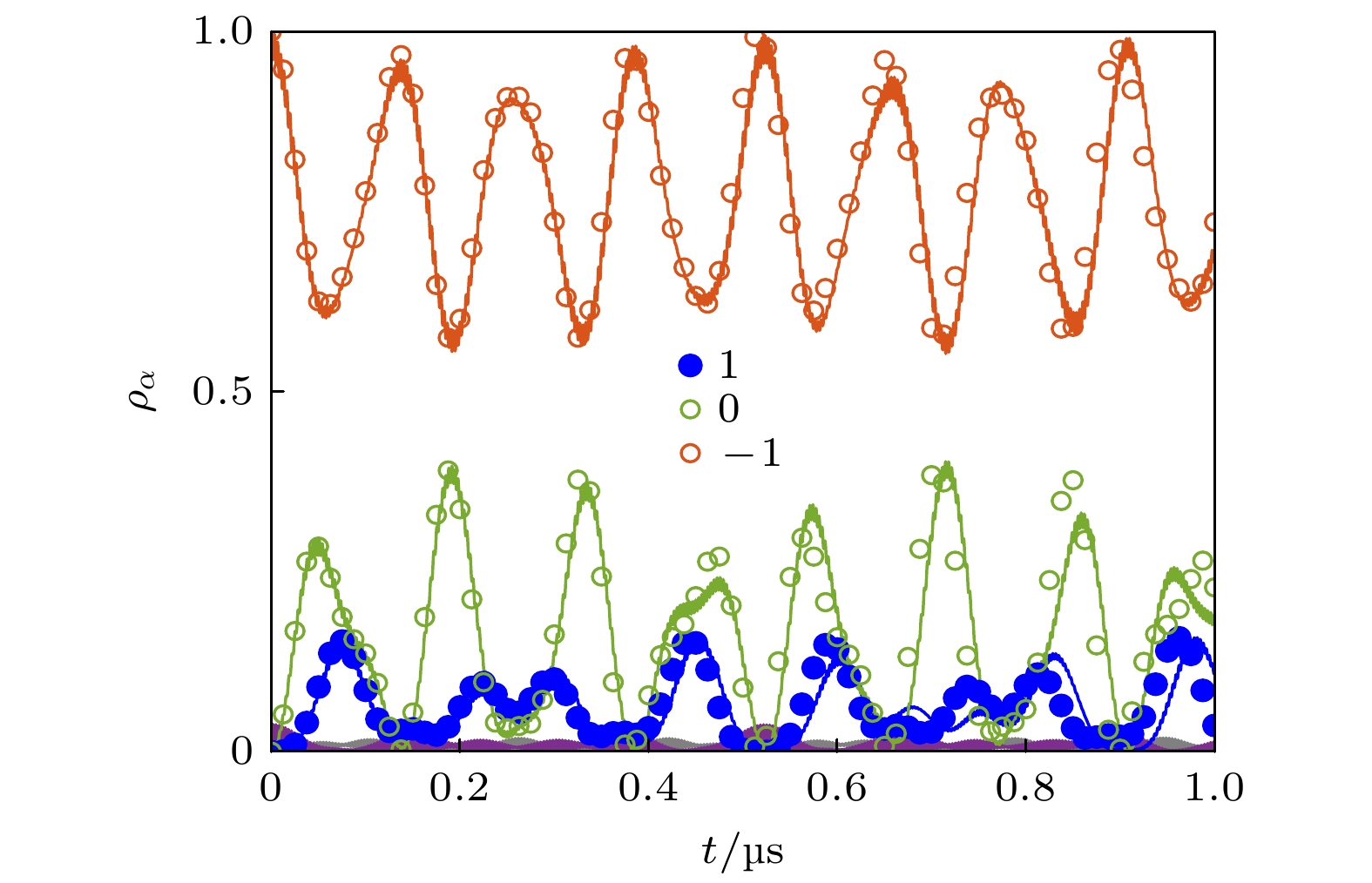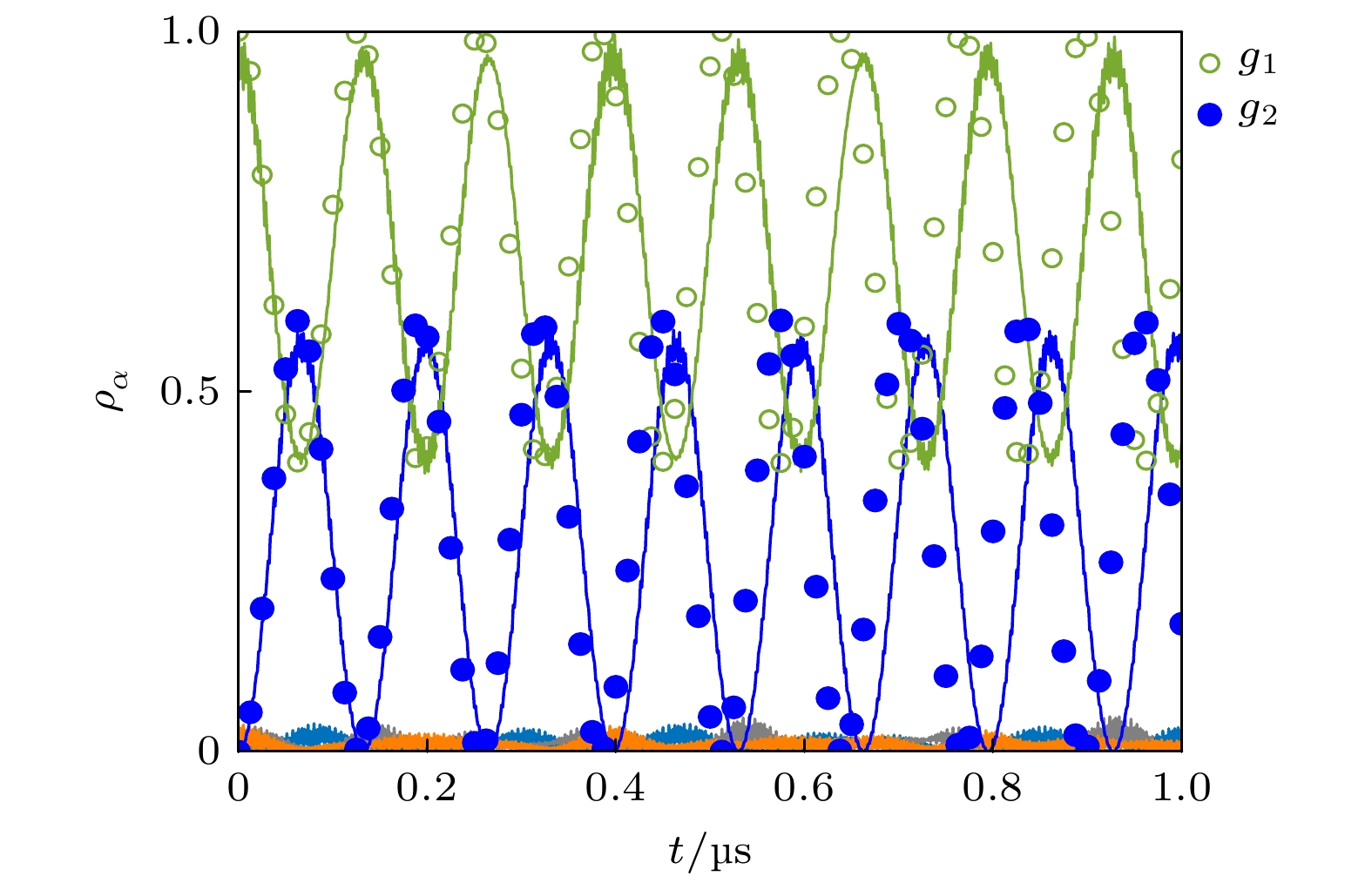-
In quantum optics, adiabatic elimination simplifies multi-level quantum system by eliminating the fast oscillatory degree of freedom and preserving the slow-varying dynamics, thus obtaining an efficient description of the system. Adiabatic elimination has important applications in quantum simulation and quantum precision measurement. For example, spin-orbit coupling has been realized in ultracold atoms by using three-level Raman coupling and adiabatic elimination. In this paper, we investigate the theoretical method and generalize the adiabatic elimination in three-level non-Hermitian systems and multi-level systems on the basis of standard elimination scheme. These can provide theoretical guidance for realizing the interdiscipline of non-Hermitian physics and spin-orbit coupling effects and their potential applications. We mainly discuss the influences of dissipative effect on the population dynamics of the system, the validity and accuracy of the adiabatic elimination theory under different parameters for both non-Hermitian and two types of five-level systems. Specifically, the dynamics satisfying the large detuning condition gives very accurate results for quite a long evolution time with the adiabatic elimination theory, but when the two-photon detuning δ and the Rabi frequency
$\varOmega $ gradually increase, leading to the violation of the large detuning condition$ \varOmega,\gamma, \delta \ll \Delta$ , the effective two-level model can no longer describe the fast-varying dynamics of the system even in a short evolution time. Thus the choice of system parameters affects the effectiveness of adiabatic elimination of the excited levels. In a non-Hermitian system, the population in the ground state oscillates with gain periodically at the beginning, while that in the ground state oscillates with loss and decreases with time, with the total population decreasing with oscillation. For long-time evolution the gain in the system causes the population to diverge, and the adiabatic elimination of the effective two-energy level system describes this behavior accurately. The effect of the non-Hermitian parameters on the dynamics of the system in the resonance case is manifested in the case that the total population remains conserved, while the total population tends to diverge for finite two-photon detuning. We find that with the increase of detuning, the divergence appears earlier and the total number of particles can be kept constant by choosing the ratio of gain to loss appropriately. This study provides a theoretical basis for state preparation and dynamical manipulation in dissipative multi-energy quantum systems.-
Keywords:
- spin-orbit coupling /
- cold atomic gas /
- adiabatic elimination /
- Raman Process
[1] Kittel C 1963 Quantum Theory of Solids (New York: John Wiley and Sons
[2] Goldman N, Juzeliūnas G, Öhberg P, Spielman I B 2014 Rep. Prog. Phys. 77 126401
 Google Scholar
Google Scholar
[3] Zheng W, Yu Z Q, Cui X L, Zhai H 2013 J. Phys. B 46 134007
 Google Scholar
Google Scholar
[4] Jian C M, Zhai H 2011 Phys. Rev. B. 84 060508
 Google Scholar
Google Scholar
[5] Zhang J Y, Ji S C, Chen Z, Zhang L, Du Z D, Yan B, Pan G S, Zhao B, Deng Y J, Zhai H, Chen S, Pan J W 2012 Phys. Rev. Lett. 109 115301
 Google Scholar
Google Scholar
[6] 焦宸, 简粤, 张爱霞, 薛具奎 2023 物理学报 72 060302
 Google Scholar
Google Scholar
Jiao C, Jian Y, Zhang A X, Xue J K 2023 Acta Phys. Sin. 72 060302
 Google Scholar
Google Scholar
[7] 施婷婷, 汪六九, 王璟琨, 张威 2020 物理学报 69 016701
 Google Scholar
Google Scholar
Shi T T, Wang L J, Wang J K, Zhang W 2020 Acta Phys. Sin. 69 016701
 Google Scholar
Google Scholar
[8] 陈星, 薛潇博, 张升康, 马余全, 费鹏, 姜元, 葛军 2021 物理学报 70 083401
 Google Scholar
Google Scholar
Chen X, Xue X B, Zhang S K, Ma Y Q, Fei P, Jiang Y, Ge J 2021 Acta Phys. Sin. 70 083401
 Google Scholar
Google Scholar
[9] Campbell D L, Price R M, Putra A, Valdés-Curiel A, Trypogeorgos D, Spielman I B 2016 Nat. Commun. 7 10897
 Google Scholar
Google Scholar
[10] Galitski V, Spielman I B 2013 Nature. 494 49
 Google Scholar
Google Scholar
[11] Stanescu T D, Anderson B, Galitski V 2008 Phys. Rev. A. 78 023616
 Google Scholar
Google Scholar
[12] Xu P, Deng T S, Zheng W, Zhai H 2015 Phys. Rev. A 103 L061302
 Google Scholar
Google Scholar
[13] Wang P J, Yu Z Q, Fu Z k, Miao J, Huang L H, Chai S J, Zhai H, Zhang J 2012 Phys. Rev. Lett. 109 095301
 Google Scholar
Google Scholar
[14] Cheuk L W, Sommer A T, Hadzibabic Z, Yefsah T, Bakr W S, Zwierlein M W 2012 Phys. Rev. Lett. 109 095302
 Google Scholar
Google Scholar
[15] Chen X L, Wang J, Li Y, Liu X J, Hu H 2018 Phys. Rev. A. 98 013614
 Google Scholar
Google Scholar
[16] Lan Z H, Öhberg P 2014 Phys. Rev. A. 89 023630
 Google Scholar
Google Scholar
[17] Chen L, Pu H, Zhang Y B 2016 Phys. Rev. A. 93 013629
 Google Scholar
Google Scholar
[18] Zhai H 2012 Int. J. Mod. Phys. B 26 1230001
 Google Scholar
Google Scholar
[19] Zhai H 2015 Rep. Prog. Phys. 78 026001
 Google Scholar
Google Scholar
[20] 贺丽, 余增强 2017 物理学报 66 220301
 Google Scholar
Google Scholar
He L, Yu Z Q 2017 Acta Phys. Sin. 66 220301
 Google Scholar
Google Scholar
[21] Geier K T, Martone G I, Hauke P, Stringari S 2021 Phys. Rev. Lett. 127 115301
 Google Scholar
Google Scholar
[22] Liao R Y 2018 Phys. Rev. Lett. 120 140403
 Google Scholar
Google Scholar
[23] Chen L, Zhang Y B, Pu H 2020 Phys. Rev. Lett. 125 195303
 Google Scholar
Google Scholar
[24] Li Y, Pitaevskii L P, Stringari S 2012 Phys. Rev. Lett. 108 225301
 Google Scholar
Google Scholar
[25] Lin Y J, Jiménez-García K, Spielman I B 2011 Nature. 471 83
 Google Scholar
Google Scholar
[26] Steck D A 2007 Quantum and Atom Optics (Eugene, Oregon: Department of Physics, University of Oregon
[27] Dalibard J, Gerbier F, Juzeliūnas G, Öhberg P 2011 Rev. Mod. Phys. 83 1523
 Google Scholar
Google Scholar
[28] Bergmann K, Theuer H, Shore B W 1998 Rev. Mod. Phys. 70 1003
 Google Scholar
Google Scholar
[29] Král P, Thanopulos I, Shapiro M 2007 Rev. Mod. Phys. 79 53
 Google Scholar
Google Scholar
[30] Brion E, Pedersen L H, Mølmer K 2007 J. Phys. A 40 1033
 Google Scholar
Google Scholar
[31] Li H, Shen H Z, Wu S L, Yi X X 2017 Optics Express. 25 30135
 Google Scholar
Google Scholar
[32] Li G Q, Chen G D, Peng P, Qi W 2017 Eur. Phys. J. D 71 14
 Google Scholar
Google Scholar
[33] Guo L P, Du L, Yin C H, Zhang Y B, Chen S 2018 Phys. Rev. A. 97 032109
 Google Scholar
Google Scholar
-
图 2 三能级Λ系统布居数动力学. 单光子失谐
$ \varDelta_1 = $ $ 595\pi $ MHz,$ \varDelta_2 = 605\pi $ MHz及$ \varOmega_1 = \varOmega_2 = 120\pi $ MHz, 初态$ |\psi_0\rangle = |g_1\rangle $ , 其中实线为消除前三能级布居数(绿线、蓝线、橙线分别代表$ |g_1\rangle $ ,$ |g_2\rangle $ ,$ |e\rangle $ 态), 圆点为消除后有效二能级系统布居数(绿点和蓝点分别代表$ |g_1\rangle $ 和$ |g_2\rangle $ 态)Fig. 2. Population dynamics of the three-level Λ system and the effective two-level system for
$ \varDelta_1 = 595\pi $ MHz,$ \varDelta_2 = $ $ 605\pi $ MHz and$ \varOmega_1 = \varOmega_2 = 120\pi $ MHz starting from the initial state$ |\psi_0\rangle = |g_1\rangle $ . Green, blue, and orange line denote the population of$|g_1\rangle $ ,$ |g_2\rangle$ ,$|e\rangle $ state before adiabatic elimination, respectively. Green and blue dots denote the population of$|g_1\rangle $ and$ |g_2\rangle$ state after adiabatic elimination, respectively.图 3 三能级Λ系统
$|g_1\rangle$ 态布居数动力学. 初态$|\psi_0\rangle= $ $ |g_1\rangle$ , 其中红线为消除前$|g_1\rangle$ 态布居数, 蓝线为消除后$|g_1\rangle$ 态布居数. 图(a)—(c)中, 双光子失谐和Rabi频率分别为$\delta=10\pi$ MHz,$\varOmega=60\pi$ MHz;$\delta=20\pi$ MHz,$\varOmega= $ $ 120\pi$ MHz;$\delta=100\pi$ MHz,$\varOmega=240\pi$ MHzFig. 3. Population dynamics of the
$|g_1\rangle$ state of the three-level Λ system for (a)$\delta = 10\pi$ MHz,$\varOmega = 60\pi$ MHz; (b)$\delta= $ $ 20\pi$ MHz,$\varOmega=120\pi$ MHz; (c)$\delta=100\pi$ MHz,$\varOmega=240\pi$ MHz starting from the initial state$|\psi_0\rangle=|g_1\rangle$ . Red and blue line denote the population of$|g_1\rangle $ state before and after adiabatic elimination, respectively.图 4 三能级非厄米Λ系统布居数动力学. 单光子失谐
$\varDelta_1= $ $ 595\pi$ MHz,$\varDelta_2=605\pi$ MHz以及$\varOmega_1=\varOmega_2=120\pi$ MHz, 耗散$\gamma_1=\gamma_2=0.2\pi$ MHz, 初态$|\psi_0\rangle=(|g_2\rangle-|g_1\rangle)/\sqrt{2}$ . 其中实线为消除前三能级布居数(绿线、蓝线、橙线分别代表$|g_1\rangle$ ,$|g_2\rangle$ ,$|e\rangle$ 态), 圆点为消除后有效二能级系统布居数(绿点和蓝点分别代表$|g_1\rangle$ 和$|g_2\rangle$ 态). 灰色虚线代表系统总布居数, 从下到上依次为双光子失谐$\delta=10\pi, 20\pi, 30\pi$ MHz. 特别地当双光子失谐为0时, 总布居数不会发散(黑色虚线)Fig. 4. Population dynamics of the three-level Λ type non-Hermitian system for
$\varDelta_1=595\pi$ MHz,$\varDelta_2=605\pi$ MHz and$\varOmega_1=\varOmega_2=120\pi$ MHz, with the dissipative parameter$\gamma_1=\gamma_2=0.2\pi$ MHz, starting from the initial state$|\psi_0\rangle=(|g_2\rangle-|g_1\rangle)/\sqrt{2}$ . Green, blue, and orange line denote the population of$|g_1\rangle $ ,$ |g_2\rangle$ ,$|e\rangle $ state before adiabatic elimination, respectively. Green and blue dots denote the population of$|g_1\rangle $ and$ |g_2\rangle$ state after adiabatic elimination, respectively. The gray dashed line represents the total population of atoms, with two-photon detunings of 10π, 20π, 30π MHz from bottom to top. Specifically when the two photon detuning is 0, the total population will not diverge (see the black dashed line).图 6 双Λ型五能级系统数值解布居数动力学. 单光子失谐
$\varDelta_1=590\pi$ MHz,$\varDelta_2=600\pi$ MHz,$\varDelta_3=600\pi$ MHz,$\varDelta_4=610\pi$ MHz, 拉比频率$\varOmega_1=\varOmega_2=\varOmega_3=\varOmega_4=120\pi$ MHz, 处在初态$|\psi_0\rangle=|-1\rangle$ . 其中实线为消除前能级布居数(蓝线、绿线、橙线、紫线、灰线分别代表$|1\rangle$ ,$|0\rangle$ ,$|-1\rangle$ ,$|a\rangle$ ,$|b\rangle$ 态), 圆点为消除后有效三能级布居数(蓝点、绿点和橙点分别代表$|1\rangle$ ,$|0\rangle$ ,$|-1\rangle$ 态)Fig. 6. Population dynamics of five-level double-Λ system fot
$\varDelta_1=590\pi$ MHz,$\varDelta_2=\Delta_3=600\pi$ MHz,$\varDelta_4=610\pi$ MHz and$\varOmega_1=\varOmega_2=\varOmega_3=\varOmega_4=120\pi$ MHz starting from the initial state$|\psi_0\rangle=|-1\rangle$ . The solid line represents the population before elimination (blue, green, orange, purple, and gray line represent levels$|1\rangle $ ,$|0\rangle $ ,$|-1\rangle $ ,$|a\rangle $ ,$ |b\rangle$ , respectively), and the circular dot represents the population of the three energy levels after elimination (blue, green, and orange dots correspond to levels$|1\rangle $ ,$|0\rangle $ ,$|-1\rangle $ , respectively)图 8 双V型五能级系统绝热消除后的数值解布居数动力学图. 单光子失谐
$ \varDelta_1 = 590\pi \;{\rm{MHz}}$ ,$ \varDelta_2 = 595\pi \;{\rm{MHz}}$ ,$ \varDelta_3 = $ $ 605\pi \;{\rm{MHz}}$ ,$ \varDelta_4 = 610\pi \;{\rm{MHz}}$ , 拉比频率$ \varOmega_1 = \varOmega_2 = \varOmega_3 = $ $ \varOmega_4 = 120\pi \;{\rm{MHz}}$ , 初态$ |\psi_0\rangle = |g_1\rangle $ . 其中实线为消除前能级布居数(绿线、蓝线、橙线、灰线、浅蓝色线分别代表$ |g_1\rangle $ ,$ |g_2\rangle $ ,$ |e_1\rangle $ ,$ |e_2\rangle $ ,$ |e_3\rangle $ 态), 圆点为消除后有效二能级的布居数(绿点和蓝点分别代表$ |g_1\rangle $ 和$ |g_2\rangle $ 态)Fig. 8. Population dynamics of the five-level double-V system for
$ \varDelta_1 = 590\pi \;{\rm{MHz}}$ ,$ \varDelta_2 = 595\pi \;{\rm{MHz}}$ ,$ \varDelta_3 = $ $ 605\pi \;{\rm{MHz}}$ ,$ \varDelta_4 = 610\pi \;{\rm{MHz}}$ and$ \varOmega_1 = \varOmega_2 = $ $ \varOmega_3 = \varOmega_4 = 120\pi \;{\rm{MHz}}$ starting from the initial state$ |\psi_0\rangle = |g_1\rangle $ . Green, blue, orange, gray, light blue line denote the population of$|g_1\rangle $ ,$ |g_2\rangle$ ,$|e_1\rangle $ ,$|e_2\rangle $ ,$|e_3\rangle $ state before adiabatic elimination, respectively. Green and blue dots denote the population of$|g_1\rangle $ and$ |g_2\rangle$ state after adiabatic elimination, respectively. -
[1] Kittel C 1963 Quantum Theory of Solids (New York: John Wiley and Sons
[2] Goldman N, Juzeliūnas G, Öhberg P, Spielman I B 2014 Rep. Prog. Phys. 77 126401
 Google Scholar
Google Scholar
[3] Zheng W, Yu Z Q, Cui X L, Zhai H 2013 J. Phys. B 46 134007
 Google Scholar
Google Scholar
[4] Jian C M, Zhai H 2011 Phys. Rev. B. 84 060508
 Google Scholar
Google Scholar
[5] Zhang J Y, Ji S C, Chen Z, Zhang L, Du Z D, Yan B, Pan G S, Zhao B, Deng Y J, Zhai H, Chen S, Pan J W 2012 Phys. Rev. Lett. 109 115301
 Google Scholar
Google Scholar
[6] 焦宸, 简粤, 张爱霞, 薛具奎 2023 物理学报 72 060302
 Google Scholar
Google Scholar
Jiao C, Jian Y, Zhang A X, Xue J K 2023 Acta Phys. Sin. 72 060302
 Google Scholar
Google Scholar
[7] 施婷婷, 汪六九, 王璟琨, 张威 2020 物理学报 69 016701
 Google Scholar
Google Scholar
Shi T T, Wang L J, Wang J K, Zhang W 2020 Acta Phys. Sin. 69 016701
 Google Scholar
Google Scholar
[8] 陈星, 薛潇博, 张升康, 马余全, 费鹏, 姜元, 葛军 2021 物理学报 70 083401
 Google Scholar
Google Scholar
Chen X, Xue X B, Zhang S K, Ma Y Q, Fei P, Jiang Y, Ge J 2021 Acta Phys. Sin. 70 083401
 Google Scholar
Google Scholar
[9] Campbell D L, Price R M, Putra A, Valdés-Curiel A, Trypogeorgos D, Spielman I B 2016 Nat. Commun. 7 10897
 Google Scholar
Google Scholar
[10] Galitski V, Spielman I B 2013 Nature. 494 49
 Google Scholar
Google Scholar
[11] Stanescu T D, Anderson B, Galitski V 2008 Phys. Rev. A. 78 023616
 Google Scholar
Google Scholar
[12] Xu P, Deng T S, Zheng W, Zhai H 2015 Phys. Rev. A 103 L061302
 Google Scholar
Google Scholar
[13] Wang P J, Yu Z Q, Fu Z k, Miao J, Huang L H, Chai S J, Zhai H, Zhang J 2012 Phys. Rev. Lett. 109 095301
 Google Scholar
Google Scholar
[14] Cheuk L W, Sommer A T, Hadzibabic Z, Yefsah T, Bakr W S, Zwierlein M W 2012 Phys. Rev. Lett. 109 095302
 Google Scholar
Google Scholar
[15] Chen X L, Wang J, Li Y, Liu X J, Hu H 2018 Phys. Rev. A. 98 013614
 Google Scholar
Google Scholar
[16] Lan Z H, Öhberg P 2014 Phys. Rev. A. 89 023630
 Google Scholar
Google Scholar
[17] Chen L, Pu H, Zhang Y B 2016 Phys. Rev. A. 93 013629
 Google Scholar
Google Scholar
[18] Zhai H 2012 Int. J. Mod. Phys. B 26 1230001
 Google Scholar
Google Scholar
[19] Zhai H 2015 Rep. Prog. Phys. 78 026001
 Google Scholar
Google Scholar
[20] 贺丽, 余增强 2017 物理学报 66 220301
 Google Scholar
Google Scholar
He L, Yu Z Q 2017 Acta Phys. Sin. 66 220301
 Google Scholar
Google Scholar
[21] Geier K T, Martone G I, Hauke P, Stringari S 2021 Phys. Rev. Lett. 127 115301
 Google Scholar
Google Scholar
[22] Liao R Y 2018 Phys. Rev. Lett. 120 140403
 Google Scholar
Google Scholar
[23] Chen L, Zhang Y B, Pu H 2020 Phys. Rev. Lett. 125 195303
 Google Scholar
Google Scholar
[24] Li Y, Pitaevskii L P, Stringari S 2012 Phys. Rev. Lett. 108 225301
 Google Scholar
Google Scholar
[25] Lin Y J, Jiménez-García K, Spielman I B 2011 Nature. 471 83
 Google Scholar
Google Scholar
[26] Steck D A 2007 Quantum and Atom Optics (Eugene, Oregon: Department of Physics, University of Oregon
[27] Dalibard J, Gerbier F, Juzeliūnas G, Öhberg P 2011 Rev. Mod. Phys. 83 1523
 Google Scholar
Google Scholar
[28] Bergmann K, Theuer H, Shore B W 1998 Rev. Mod. Phys. 70 1003
 Google Scholar
Google Scholar
[29] Král P, Thanopulos I, Shapiro M 2007 Rev. Mod. Phys. 79 53
 Google Scholar
Google Scholar
[30] Brion E, Pedersen L H, Mølmer K 2007 J. Phys. A 40 1033
 Google Scholar
Google Scholar
[31] Li H, Shen H Z, Wu S L, Yi X X 2017 Optics Express. 25 30135
 Google Scholar
Google Scholar
[32] Li G Q, Chen G D, Peng P, Qi W 2017 Eur. Phys. J. D 71 14
 Google Scholar
Google Scholar
[33] Guo L P, Du L, Yin C H, Zhang Y B, Chen S 2018 Phys. Rev. A. 97 032109
 Google Scholar
Google Scholar
计量
- 文章访问数: 5418
- PDF下载量: 197
- 被引次数: 0
















 下载:
下载:
































































































































